July 27th, 2014 §
I stuck a spring of borage into one of my homegrown bouquets and have fallen even more in love with this most-beautiful herb. In the indirect light of my foyer the zillion tiny hairs along each stem appear to glow. It is a magical-looking plant, and one I connect with deeply.
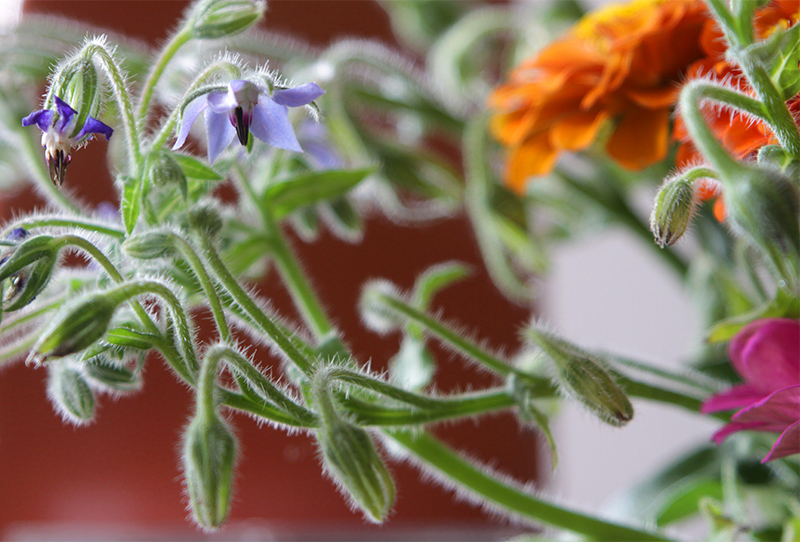
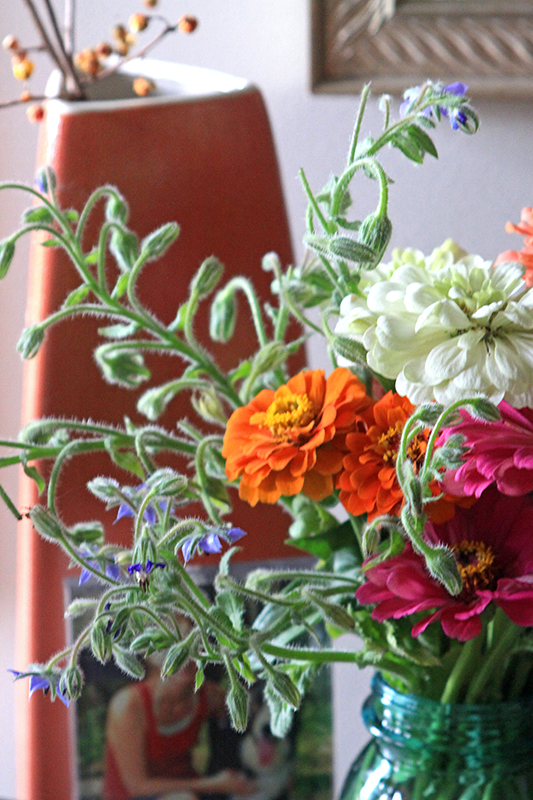
I grew this borage from seed, direct-sown this spring. It definitely needs a lot of sun—the seed I sowed in the shadow of some other plants failed to thrive, but the plants in the sun grew huge and vigorous and are covered with blooms. I didn’t expect it to do well as a cut flower—many herbs wilt in the house—but it’s proven to be a tremendous asset to my flower arrangements. And it’s a timely discovery, as one of my gardening goals this year was to expand my palette of cut flowers.
July 15th, 2014 §
You’d be forgiven for thinking the name of this blog should be Bugs, Birds and Buck Mountain. Posting has been heavy on the natural history lately, I suppose because I want to keep a record of the creatures that share this land with me. That, and baby birds are just cool.
But fear not—there is still some farming happening at Bonafide Farm, and as it’s been months since the last vegetable garden update that’s what we’ll do today.

I will be the first to admit that I am not in love with this garden this year, for several reasons. First, when I planted it in April I was pretty sure I would be moving away from the farm at the end of summer and didn’t think too seriously about where I put things. Second, the overwintered greens took up a vast amount of valuable real estate, and though I enjoyed them as we emerged from winter we had a long, cool spring and I didn’t get to pull them out to use their space for something else until just now, when it’s really too hot and dry to get much going. Finally, my veg garden is just too small, and plants are packed too tightly for all of them to get the sunlight they need to thrive. I hate working around them when they are so thick, always worrying about brushing against a wheel bug or hidden wasp nest.
I haven’t yet expanded the garden because that requires another goat rope of getting huge posts, pounding them in, digging in chicken wire around the perimeter, etc., not to mention beginning to improve the soil by shoveling tractor buckets of compost, all of which is doable but after having spent four painful months and thousands of dollars on a rotator cuff injury this winter I am leery of straining my still-fragile shoulder.
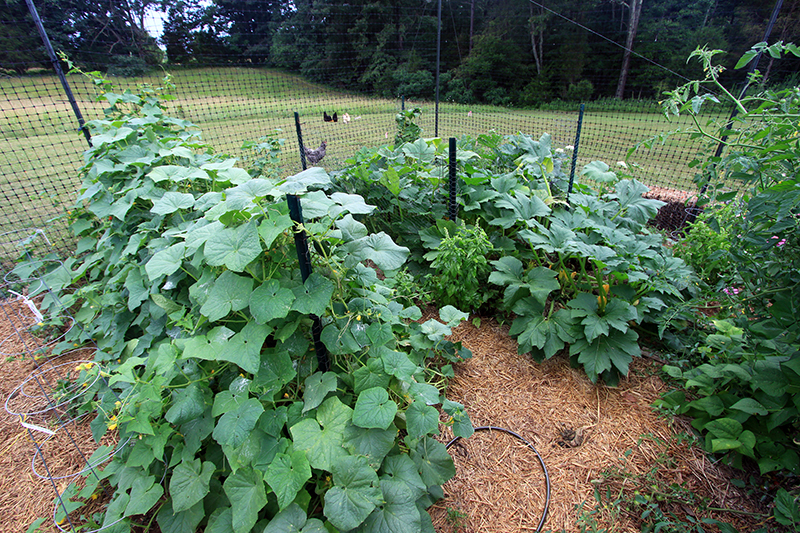
So, the garden is what it is. It’s not the most organized or pretty but it’s putting out vegetables and flowers and that’s all I suppose it really has to do. There have been some surprises this season. The most notable is that my squash, which usually falls victim to squash bugs around the time it’s ready to harvest, is chugging along just fine. It’s in the photo above, to the right of the massive cucumber installation. I don’t know if the polar vortex is behind this lower squash bug population this year, or if it has to do with moving the squash to a new location in the garden. I do know that for the first time ever I am using an “organic” pyrethrin dust, which I applied when the plants were young and every so often now. I don’t think that’s entirely the reason, though, as it’s a contact insecticide, not really a repellant, and I just haven’t seen much evidence of squash bugs or their eggs. Of course I may be totally jinxing myself by even writing this. The irony is I planted the squash in amongst other things, anticipating that it would be dead by now and the other plants could take over. But that’s not how it’s turning out, and I suppose I shouldn’t be complaining about something living instead of dying!

Again I am overrun with cucumbers. I think it’s because when you buy little two-leafed cuke seedlings they come about eight to a pot so it’s easy to overplant. Nobody needs this many cucumbers. But again, like with the squash, I expected these plants to have fallen to the cucumber beetles by now and they haven’t. The chickens are getting a lot of cucumbers.
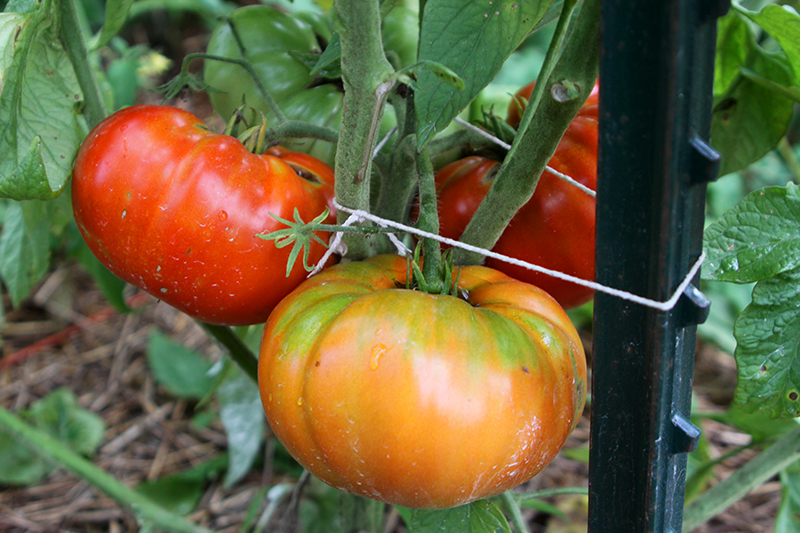
The tomatoes are all now mostly taller than I, and I am trying a new technique with them in that I did not pinch off any suckers. All my life I was of the “pinch the suckers” school of tomato growing, but this year I thought I’d let them go and see what happened. What happened was massive plants that I tried to tie up last night, which required full-body hugging the plants as I collected each vine near the post. I guess tomatoes need love too. Even planted on generous 36″ centers, the plants are growing together making harvest hard. But I did pick my first big tomatoes last night, with “Early Girl” for the win, and others are right behind. That’s “Brandywine” above, nice and big. The plants are gorgeous and healthy, with just the tiniest bit of manageable fungus-related yellowing near the base.
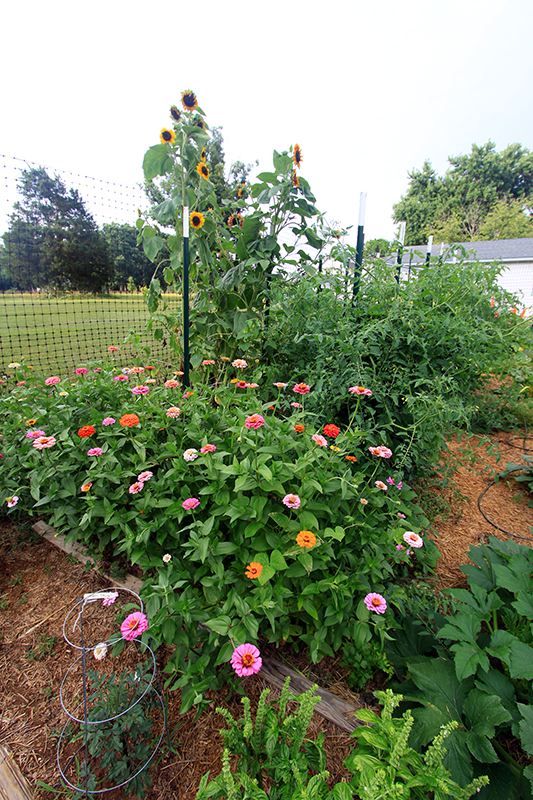
I have a few rows of cutting flowers—zinnias and cosmos, and some volunteer gladiolus that I tried to dig out this spring but obviously I didn’t manage to get all the bulbs. There are lots of surprises that germinated from years’ past and I just let go, such as random green beans, unidentified greens, the sunflowers above, and a very mysterious white squash rambling through the cosmos. Like I said, kind of a mess.
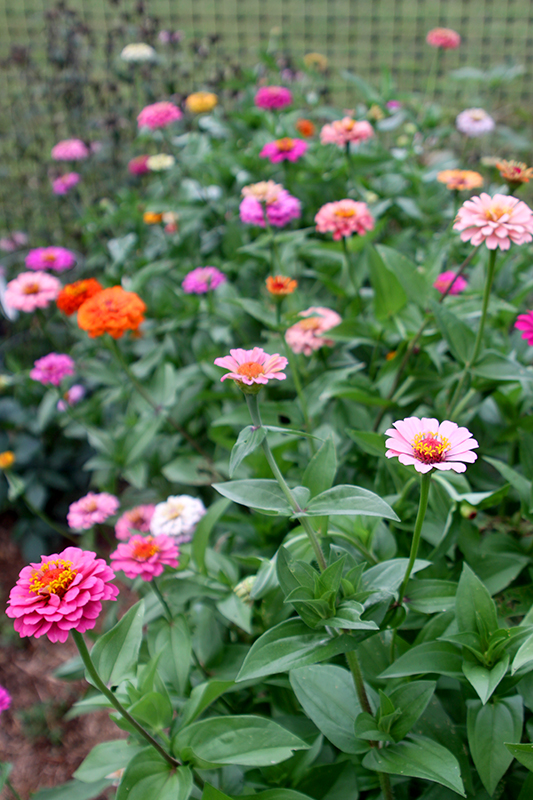
But here we are, mid-July, and this is what I have to work with. The summer is going so fast that I know it will be only a few more weeks before everything goes round the bend and starts its late-summer decline.
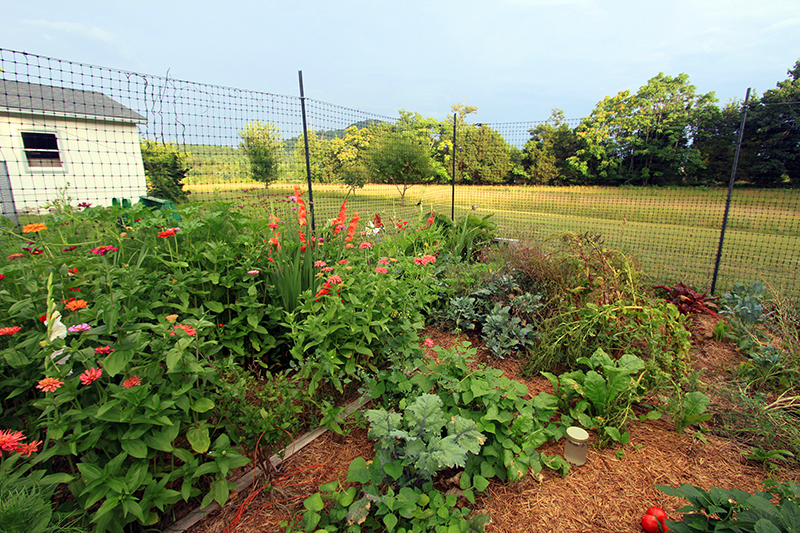
And the nice thing about gardening is that each year you get a do-over. Maybe this fall I will get the garden expanded and then have fresh land to cultivate next year. I really want to put in a ton of perennial fruits and vegetables that need space to mature, such as berry bushes, asparagus, rhubarb, and strawberries, so that’s a good incentive to get out the dreaded t-post driver.
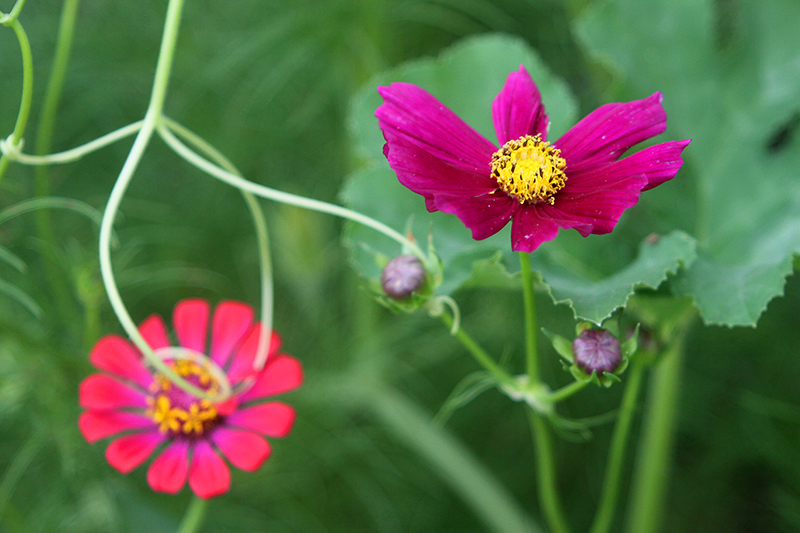
June 26th, 2014 §
This is the first harvest of summer 2014—a few squash and zucchini that managed to outrun the oncoming squash bugs, some hot peppers, basil and other herbs, and five Sun Sugar tomatoes. Tomatoes before the fourth of July—not bad considering our long, cold spring.
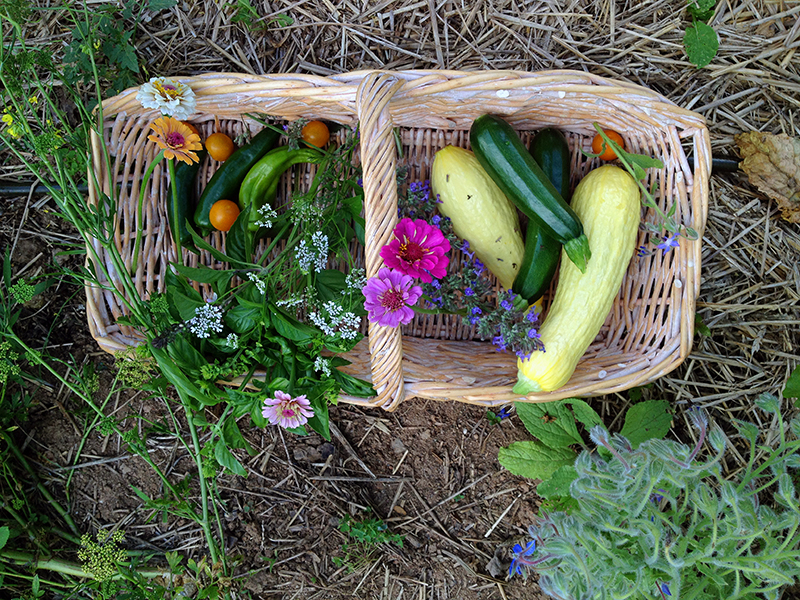
The zinnias are just coming on, and I bet tomorrow I will see the first cosmos bloom. It is great to be back in the cutting flower business. From now until frost there will be homegrown bouquets all around my house. 
Such bounty calls for a celebration with fire. As I didn’t do much for the Solstice this past weekend, I fired up the grill to cook a first harvest/Solstice feast as thunder bounced around the mountains. I just got the grill a few weeks ago, a gift from my mom, and it’s been a steep learning curve to understand this entirely new way of cooking. It’s a good challenge, and one I needed as my culinary selfeducation had grown stagnant. It feels wonderful to push myself, to make mistakes, have “eureka” moments and accidental epiphanies, and at the end of it all, if I’m lucky, dinner.
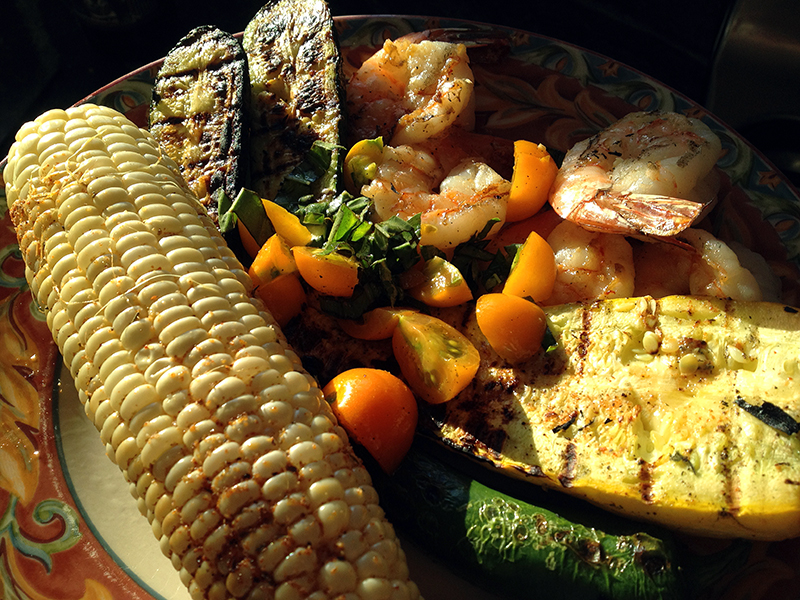
And what a dinner it was. Garlic shrimp, my veg, some corn slathered with butter and seasonings and wrapped back up in its husk to grill. A simple, perfect salsa made with my five pretty gold tomatoes, basil, salt, pepper and olive oil. These squash were on a whole other level from the pallid supermarket varieties I grilled last week. Call me a tree-hugging hippie, but I can taste a difference when I eat something I planted in April as a two-leafed seedling, nurtured and protected, and finally harvested within twenty minutes of consuming. Vegetables taste alive, almost meat-like in their nutrition and vitality. They go straight to my brain.
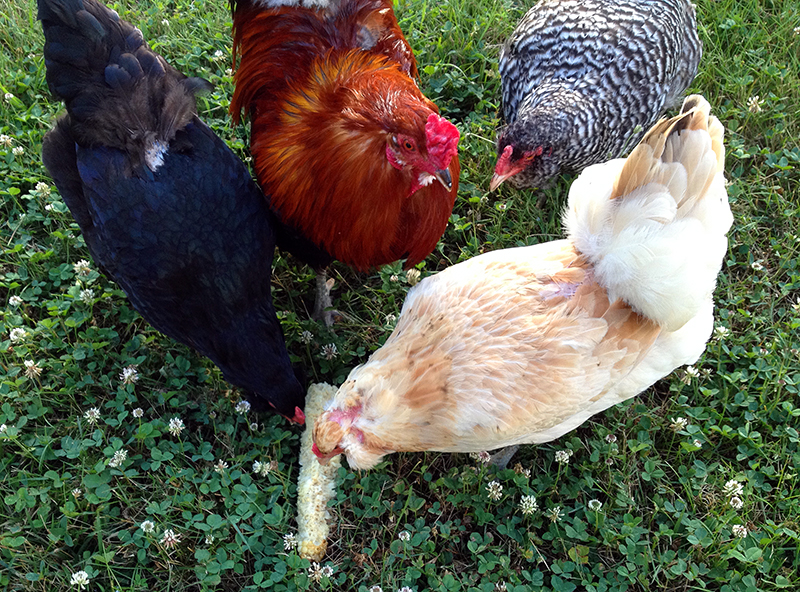
And, nothing is wasted.
November 3rd, 2013 §
Anytime after the first freeze of fall I am on the lookout for a few days of nice weather in order to put the garden to bed. This weekend was perfect for the job, with temperatures in the 60s, bright blue skies and sun streaming through the red, orange and yellow trees. Such glorious weather is, I suppose, a small consolation for what is one of my saddest markers of seasonal change. Take a look at this pathetic sight:
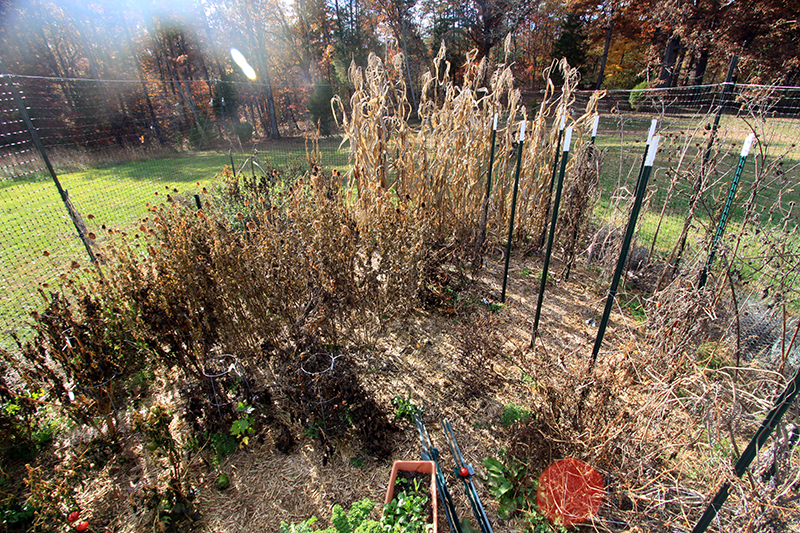
I started with the tomatoes, cutting them down from their stakes.
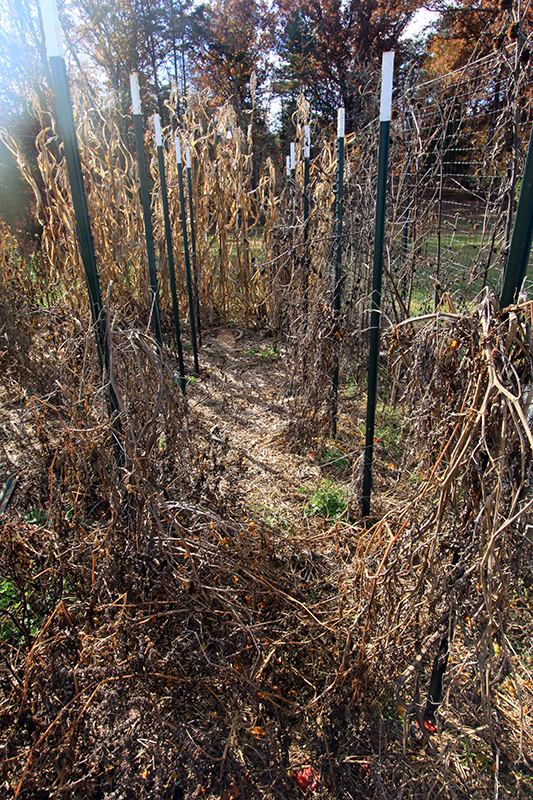
I always use cotton or jute twine to stake my tomatoes so that at the end of the season everything can go right in the compost, which beats having to pick pieces of plastic or wire out of the jumbled vines. I wasn’t too meticulous with picking up the dropped fruit as I plan on running the chickens in here during winter and they will appreciate the treats.
Then I moved on to ripping up the cosmos and zinnias, and as I did I saved seed heads from varieties that did particularly well. I plan to scatter these seeds over some bare spots in hope of starting a wildflower patch.

Then I cut the hyacinth bean vines off of the deer fence. A tedious job, indeed, to avoid cutting the plastic fence. Next year I will sow my hyacinth bean up the sides of the metal chicken run. Finally I pulled the frozen peppers out. I was annoyed at myself to find that there were so many peppers that I hadn’t harvested before it was too late. This is what happens when the first frost happens when the farmer is out of town for a couple of days!

Then I took a break from the vegetable garden to walk through the pastures, cutting out the prickly shrubs that are the first woody plants to initiate reforestation of cleared areas. It took several big tractor bucket loads to get everything to the compost and brush piles in the woods.
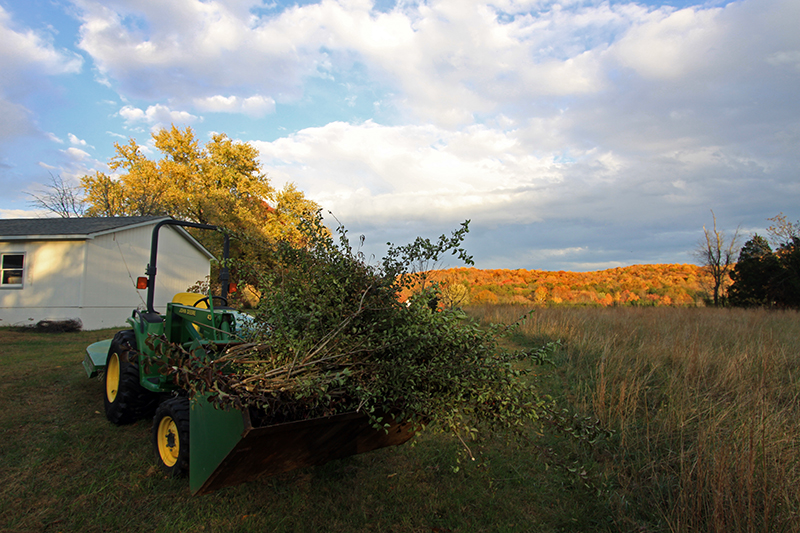
By then the sun was setting and I had been working outside for more than seven hours in a row. So when the chickens headed into roost, I did the same, straight for a hot epsom salt bath. Up next: day two of vegetable garden cleanup.
October 16th, 2013 §
I found this lone monarch feasting amongst the zinnas last week. Given all the trouble monarchs are in, I was very happy to see it and to know I’d done my part to cultivate a delicious banquet of nectar-rich flowers. I wonder if this butterfly was refueling on its migration to Mexico?
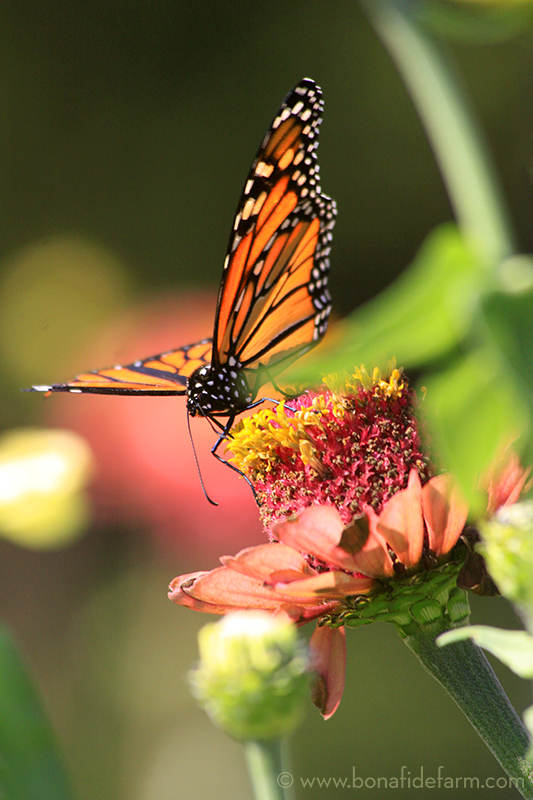
Monarch butterflies are decreasing at an alarming rate: 59% in the last year according to a survey carried out during the 2012-2013 winter season by the WWF-Telcel Alliance, and Mexico’s National Commission of Protected Areas (CONAP). The numbers of monarchs are at their lowest numbers in 20 years. According to the same organization:
The latest decrease in monarch butterflies is likely due to a decrease in the milkweed plant (Asclepias) – a primary food for monarchs – from herbicide use in the butterfly’s reproductive and feeding grounds in the US, as well as extreme climate variations during the fall and summer affecting butterfly reproduction.
Why should you care if monarch numbers are decreasing? Because monarchs, like all insects, are pollinators. In simplest terms, without pollinators we won’t have any of the foods that require pollination, no fruits or vegetables, and these are the healthiest foods we can eat. And even a food that doesn’t appear to be a vegetable, such as bread, starts life as a plant that probably needs to be pollinated.
So if we want to keep eating, we have to cultivate what pollinators need to thrive and eliminate the use of what’s killing them—pesticides and herbicides. In the case of the monarch, their most important food is milkweed. There are some native milkweeds in this area, and one of the reasons I don’t mow some of my fields is to let these “weeds” flower to feed the monarchs. Even so, these butterflies need more milkweed. It’s one of my goals to some day make a formal monarch garden, rich with milkweeds, to try to encourage monarchs to breed and cocoon right here.
If you’ve never seen a monarch cocoon in person, it’s worth planting a butterfly garden just for a chance to spy this treat. The cocoons are the most beautiful color of Jadeite green and are decorated with spots of pure, shining gold. They look like precious jewels. When the monarch is about to hatch, the cocoon turns translucent and you can see the orange and black butterfly folded up inside. When it emerges, it’s all wet, sticky and deflated, and it must sit and slowly pump its wings until its blood inflates them. Truly fascinating and beautiful to watch in person.
For even more on the monarchs, visit monarchwatch.org. And for a scientifically literary take on the monarchs’ plight, read Flight Behavior, by Barbara Kingsolver, one of my most favorite authors.




















